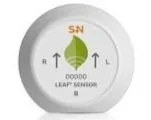Helping patients turn a new LEAF
Saint Joseph Hospital now uses the LEAF pressure-injury monitoring system on all adult inpatient units as part of a muti-faceted, targeted campaign to decrease HAPIs that began in 2023.
According to Scott Whittal, Saint Joseph nursing director, the occurrence rate of hospital-acquired pressure ulcers started rising during the COVID years of 2020 and 2021, and then peaked in 2023.
Clinical leadership responded aggressively to this concerning trend. They launched a comprehensive educational program for bedside clinicians aimed at improved awareness of HAPIs and how to prevent them and instituted weekly audits of the HAPI-prevention practices in each clinical area.
“These interventions have helped improve our HAPI rates and they will continue,” Whittal said, “but they have not reduced our rates to the levels we targeted at the beginning of this campaign. To complement our effort and accelerate our progress, we’ve added wearable technology that gives us real-time data and enables us to optimize our HAPI-prevention care.”
This emerging market of wearable HAPI-prevention tech is a crowded one. To select the correct device for Saint Joseph’s patients, the Wound Care team analyzed patient data and found a key, determining metric: On average, HAPIs at Saint Joseph develop within seven to 12 days of admission.
“This led us directly to the LEAF sensor, which provides more of the information we need for our most common at-risk patients, including the patient’s turn angle, ambulation time and time spent in various positions,” Whittal said. “Using trend information provided by the LEAF device, we’re able to identify how effectively we’re offloading pressure to reperfuse skin tissue.”
LEAF sensors are now available on all adult inpatient units – floors 5, 6 and 7. Patients who meet one of these three criteria will be fitted with LEAF sensors:
An existing pressure injury.
A Braden Scale score of 18 or less. A score is developed based on an assessment of six risk factors: sensory perception, exposure to moisture, degree of physical activity, ability to shift body position, nutrition, and amount of friction against the skin.
Malnutrition diagnosed by our own registered dietitians.
Clinical teams started using the sensors at Saint Joseph in December. That month tied for the lowest observed HAPI count for the entire year: five.
“It's a little early to draw any significant conclusions,” Whittal said. “What we can say is that HAPI prevention is on the minds of our frontline clinicians. In the past 30 days, all patients with the LEAF system have been turned according to protocols 87 percent of the time. According to the LEAF vendor, this level of compliance with the protocols is outstanding compared with other hospitals in their portfolio.”
Thank you to all physicians and APPs who’ve supported this initiative and increased their focus on HAPI prevention. Clinicians with questions can contact Whittal at scott.whittal@imail.org.

